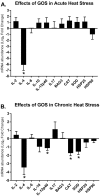Splenic Gene Expression Signatures in Slow-Growing Chickens Stimulated in Ovo with Galactooligosaccharides and Challenged with Heat
- PMID: 32178295
- PMCID: PMC7143207
- DOI: 10.3390/ani10030474
Splenic Gene Expression Signatures in Slow-Growing Chickens Stimulated in Ovo with Galactooligosaccharides and Challenged with Heat
Abstract
Galactooligosaccharides (GOS) that are delivered in ovo improve intestinal microbiota composition and mitigate the negative effects of heat stress in broiler chickens. Hubbard hybrids are slow-growing chickens with a high resistance to heat. In this paper, we determined the impact of GOS delivered in ovo on slow-growing chickens that are challenged with heat. The experiment was a 2 × 2 × 2 factorial design. On day 12 of incubation, GOS (3.5 mg/egg) was delivered into the egg (n = 300). Controls (C) were mock-injected with physiological saline (n = 300). After hatching, the GOS and C groups were split into thermal groups: thermoneutral (TN) and heat stress (HS). HS (30 °C) lasted for 14 days (days 36-50 post-hatching). The spleen (n = 8) was sampled after acute (8.5 h) and chronic (14 days) HS. The gene expression of immune-related (IL-2, IL-4, IL-6, IL-10, IL-12p40, and IL-17) and stress-related genes (HSP25, HSP90AA1, BAG3, CAT, and SOD) was detected with RT-qPCR. Chronic HS up-regulated the expression of the genes: IL-10, IL-12p40, SOD (p < 0.05), and CAT (p < 0.01). GOS delivered in ovo down-regulated IL-4 (acute p < 0.001; chronic p < 0.01), IL-12p40, CAT and SOD (chronic p < 0.05). The obtained results suggest that slow-growing hybrids are resistant to acute heat and tolerant to chronic heat, which can be supported with in ovo GOS administration.
Keywords: GOS; heat; immune response; in ovo stimulation; prebiotic; spleen.
Conflict of interest statement
The authors declare no conflict of interest. The funders had no role in the design of the study; in the collection, analyses, or interpretation of data; in the writing of the manuscript, or in the decision to publish the results.
Figures


Similar articles
-
Embryonic modulation through thermal manipulation and in ovo feeding to develop heat tolerance in chickens.Anim Nutr. 2023 Jan 17;13:150-159. doi: 10.1016/j.aninu.2023.01.005. eCollection 2023 Jun. Anim Nutr. 2023. PMID: 37123616 Free PMC article. Review.
-
Avian model to mitigate gut-derived immune response and oxidative stress during heat.Biosystems. 2019 Apr;178:10-15. doi: 10.1016/j.biosystems.2019.01.007. Epub 2019 Jan 16. Biosystems. 2019. PMID: 30659866
-
Impact of galactooligosaccharides delivered in ovo on mitigating negative effects of heat stress on performance and welfare of broilers.Poult Sci. 2020 Jan;99(1):407-415. doi: 10.3382/ps/pez512. Epub 2019 Dec 30. Poult Sci. 2020. PMID: 32416825 Free PMC article.
-
Performance and meat quality traits of slow-growing chickens stimulated in ovo with galactooligosaccharides and exposed to heat stress.Poult Sci. 2022 Aug;101(8):101972. doi: 10.1016/j.psj.2022.101972. Epub 2022 May 21. Poult Sci. 2022. PMID: 35760001 Free PMC article.
-
Effect of galactooligosaccharides delivered in ovo on meat quality traits of broiler chickens exposed to heat stress.Poult Sci. 2020 Jan;99(1):612-619. doi: 10.3382/ps/pez556. Epub 2019 Dec 30. Poult Sci. 2020. PMID: 32416849 Free PMC article.
Cited by
-
Embryonic modulation through thermal manipulation and in ovo feeding to develop heat tolerance in chickens.Anim Nutr. 2023 Jan 17;13:150-159. doi: 10.1016/j.aninu.2023.01.005. eCollection 2023 Jun. Anim Nutr. 2023. PMID: 37123616 Free PMC article. Review.
-
In-ovo stimulation trains innate immunity to mitigate Campylobacter jejuni in broiler chickens.Poult Sci. 2025 May 29;104(9):105368. doi: 10.1016/j.psj.2025.105368. Online ahead of print. Poult Sci. 2025. PMID: 40483907 Free PMC article.
-
Muscle Antioxidant Activity and Meat Quality Are Altered by Supplementation of Astaxanthin in Broilers Exposed to High Temperature.Antioxidants (Basel). 2020 Oct 23;9(11):1032. doi: 10.3390/antiox9111032. Antioxidants (Basel). 2020. PMID: 33113990 Free PMC article.
-
Modulatory effects of in ovo delivery of galactooligosaccharide and Lactiplantibacillus plantarum on antioxidant capacity, gene expression, and selected plasma metabolite parameters of broiler chickens.J Appl Genet. 2025 May;66(2):421-434. doi: 10.1007/s13353-024-00931-7. Epub 2024 Dec 12. J Appl Genet. 2025. PMID: 39666172 Free PMC article.
-
Chicken anemia virus inhibits hematopoiesis and development of chicken embryo.Poult Sci. 2025 Apr;104(4):104857. doi: 10.1016/j.psj.2025.104857. Epub 2025 Jan 27. Poult Sci. 2025. PMID: 40036936 Free PMC article.
References
-
- Roushdy E.M., Zaglool A.W., El-Tarabany M.S. Effects of chronic thermal stress on growth performance, carcass traits, antioxidant indices and the expression of HSP70, growth hormone and superoxide dismutase genes in two broiler strains. J. Therm. Biol. 2018;74:337–343. doi: 10.1016/j.jtherbio.2018.04.009. - DOI - PubMed
-
- Reay D., Reay D. Climate-Smart Food. Springer International Publishing; New York City, NY, USA: 2019. Climate-Smart Chicken; pp. 107–120.
Grants and funding
LinkOut - more resources
Full Text Sources
Research Materials
Miscellaneous

